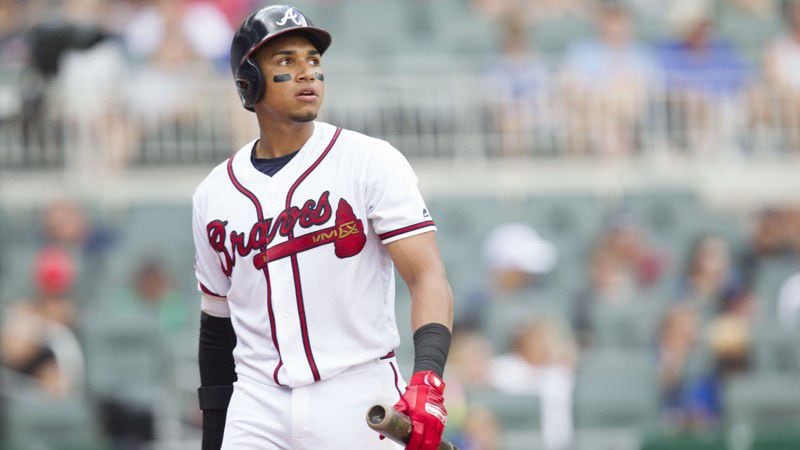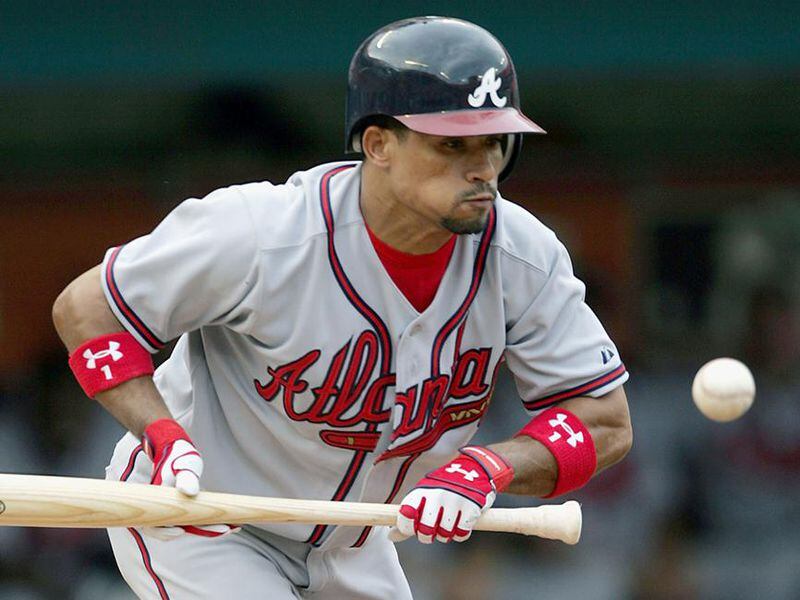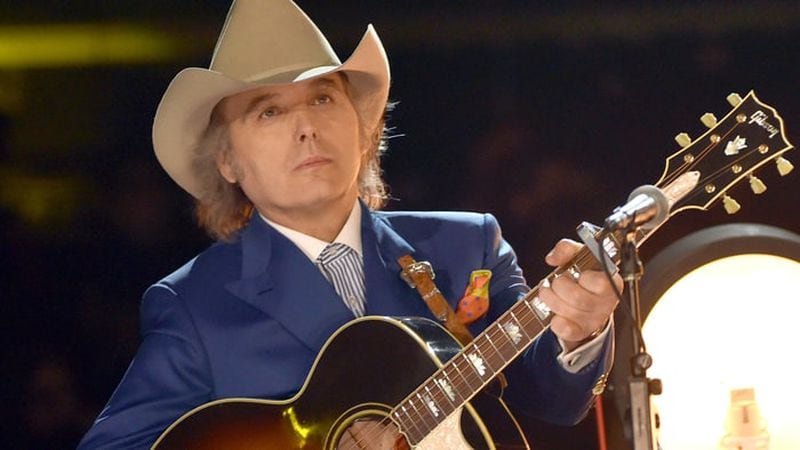It’s safe to say that 110 games into this Braves season, no one anticipated they’d have Johan Camargo at shortstop, Brandon Phillips at third base, Ozzie Albies at second base and Dansby Swanson in Triple-A, playing primarily shortstop but also some second base.
But things change, as everyone must realize by now. Especially with a rebuilding team, things are fluid. Extremely.
So here’s my answer to all of those who’ve asked some variation of the question, "what is going on with the Braves infield?"
After the extended struggles that buried Swanson statistically and eventually got him sent to Triple-A, and after Camargo’s resounding first couple of months in the big leagues made it clear he might be even better than the Braves thought when they added him to the 40-man roster last fall, the Braves are now evaluating the pieces they have – specifically the three rookies Albies, Swanson and Camargo – and trying to get them as many at-bats as possible during this period, providing them the best opportunity to play every day as team officials consider the big picture.
While plenty of those outside the organization already made decisions on this guy being a utility guy or that one being the long-term shortstop or that one being untouchable, and on and on, the Braves have not made those decisions. They know things change and there’s no reason to lock themselves into a plan when that plan might no longer be what's most beneficial one for the team. Maybe it is, but maybe it’s not. They’ll determine that now and during the offseason.
So that’s where we’re at with that.
Now, let's briefly dive deeper into the Camargo situation. As in the curious case of so many being reluctant to climb on his bandwagon when he came barreling out of the blocks in his first couple of months in the big leagues, despite the fact he’s a dynamic talent who plays hard, has above-average speed, line-drive power, above-average defensive skills at three infield positions, an absolute cannon for an arm – I mean, what’s not to like? The dude is fun to watch and he makes things happen.
Unless it’s just the fact that for now, he’s taken Dansby’s position. Hey, this is a business, and the Braves had to do what they thought best for Dansby and the team, and at a certain point Dansby’s struggles had reached a point where they thought it counterproductive to continuing playing him every day, then saw no reason to keep him in big leagues if he wasn’t playing every day.
To blame Camargo, 23, or to be unfairly critical of him simply because he played so well while Dansby was struggling is, frankly, ridiculous.
But look at Camargo’s past month, folks on Twitter tell me. Look at his BABIP, they tell me. It’s unsustainable, they say, using the word that’s as fashionable with some in baseball circles now as “score the ball” was with basketball insiders. And I understand the argument for his BABIP (batting average on balls in play) being unlikely to remain as high as it was early on.
But the other argument, about him never having power in the minors so he can’t have it now? That's not so relevant, if you’re aware of how much this guy has changed his body in the past two years. He’s put on 20 pounds and most of it appears to be solid muscle. To say he can’t have pretty good power as a 185-pound guy in his early 20s because he didn’t have it as a 160-pounder before he was 21 isn’t a sound argument.
Things change. Young players change.
Maybe Camargo is "just" a utility player as many initially projected. But maybe he's utility player the way Martin Prado or Omar Infante was a utility player. Or, maybe Camargo could become the starter at shortstop or third base. Nothing is set in stone at this point, nor does it need to be.
This kid is a really talented player. Chipper Jones saw it two spring trainings ago, and I trust Chipper’s judgment in evaluating players as much as I do anyone’s. From what I’ve seen since this spring training, he was right about Camargo and about Ronald Acuna (the other guy Chipper was blown away by two spring trainings ago on the backfields at Dark Star.)
Camargo in the past month? In exactly the past month (since 7/8) he has this slash line: .295/.347/.489 (.836) with eight doubles, three home runs.
Now, yes, you can subtract his first five games in that period and make it since July 17, and then you have a last-20-games slash of .230/.278/.378 (.657).
But you could also add a few games to that initial one-month span, go back to July 5, and get this slash for his past 28 games: .309/.356/.505 (.861), with 10 doubles and three homers. Point is, you can kind of make the stats help say anything you want them to.
Some can’t seem to see the forest for the trees, or appreciate what’s in front of them because perhaps they’re stuck on what they thought Camargo was or what they heard he should be. Here’s the facts: In his first 63 games (197 plate appearances) in the big leagues he’s hit .292 with 22 extra-base hits (three home runs) and a .781 OPS that is tied for seventh among National League rookies who have at least 175 plate appearances.
He’s tied with Padres center fielder Manuel Margot for fourth in WAR among NL rookies at 1.0, behind only Cody Bellinger (3.3), 30-year-old Manny Pina (2.4) and Josh Bell (1.3).
The other argument I’m hearing from some Camargo detractors: He’s struggling against right-handers. Let’s examine that.
He’s a switch-hitter who has hit a stunning .404 (23-for-57) against lefties with 11 extra-base hits (two homers), a .424 OBP and .684 slugging percentage – yes, .684 slugging – for a 1.108 OPS, compared with just .242 (31-for-128) vs. righties with 11 extra-base hits (one homer), a .285 OBP and .352 slugging (.636 OPS).
But this is not that uncommon for a young switch-hitter. Well, the 1.108 OPS vs. lefties is uncommonly high, but the .636 OPS vs. righties is not unusually low, not for a rookie switch-hitter in his first few months in the big leagues.
Remember Rafael Furcal? As a rookie switch-hitter in 2000 had an impressive slash in 359 at-bats vs. righties: .306/.404/.409 (.813 OPS) with 25 extra-base hits (four triples, four homers). But in 96 at-bats vs lefties he did this: .250/.357/.281 (.638 OPS) with three extra-base hits (all doubles).
Oh, and he won the NL Rookie of the Year award.
I’m not saying Camargo is Furcal, and he certainly isn’t going to win the NL ROY award – that’s been Bellinger’s for some time -- but to repeat, Camargo has a .404 average and 1.108 OPS vs. lefties and a .242 average and .636 OPS vs. righties.
Furcal as a rookie had a .250 average and .638 OPS vs. lefties and a .306 average and .813 OPS vs. righties.
For his career, Furcal ended up with entirely different splits: .289 average and .787 OPS in 1,801 plate appearances vs. lefties, and a .278 average and .735 OPS in 5,436 PAs vs. righties.
The point being, give it time.
It’s tough enough for any young hitter to develop consistency at the big-league level, but even more for a rookie switch-hitter. And, I might add, Camargo also is a switch-hitter who’s played multiple defensive positions in his first months in the big leagues. Which is atypical and also impressive.
Sticking with Furcal for a moment, consider this:
In Furcal’s first 35 games as a rookie in 2000, he hit .340 (36-for-106) with 10 stolen bases and an .818 OPS.
In his next 25 games he hit .225 (16-for-71) with three stolen bases and a .675 OPS.
In Camargo’s first 42 MLB games (26 starts) he hit .333 (37-for-111) with a .359 OBP and .505 slugging percentage (.863 OPS).
In 21 games (20 starts) since then Camargo has hit .230 (17-for-74) with a .278 OBP and .378 slugging (.657 OPS).
Just FYI, Brian Snitker is a protégé of Bobby Cox, one of his good friends. They talk often.
Cox kept playing Furcal – good thing there was no Twitter in 2000 – and Furcal went on to finish the season with a .295 average, .394 OBP, .382 slugging percentage (.776 OPS), 40 stolen bases and, as mentioned, was NL Rookie of the Year.
• Let's close with this one from the great Dwight Yoakam
"THINGS CHANGE" by Dwight Yoakam
She said "baby things change".
I said "But I feel the same"
She said "well let me explain, baby how things can change"
I said "but that doesn't show, how a love that could grow,
would become so estranged"
She said "well baby things change"
She said "Na na na na na na na, now baby dont try,
To figure this out or ask questions 'bout why
Forever's a promise no love can survive,
And trust with hearts, just don't apply"
She said "Cause baby things change"
Na na na na na na na, so baby I quit tryin,
To figure things out about all your hearts lyin'.
Forever's a promise we couldn't survive,
Yeah, I may be slow, but I ain't blind
She said "I still love you so"
I said "I don't care to know"
She said "You once cried my name"
I said "Well baby things change
Let's don't go placing no blame,
Cause you know things can change"
na na na na na na, na na na na na na
She said "You once cried my name"
I said "Well baby things change"
na na na na na na, na na na na na na
Let's don't go placing no blame,
Cause you know things can change"
na na na na na na....
About the Author








